Hunting Open Country Elk
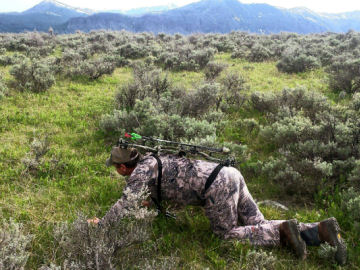
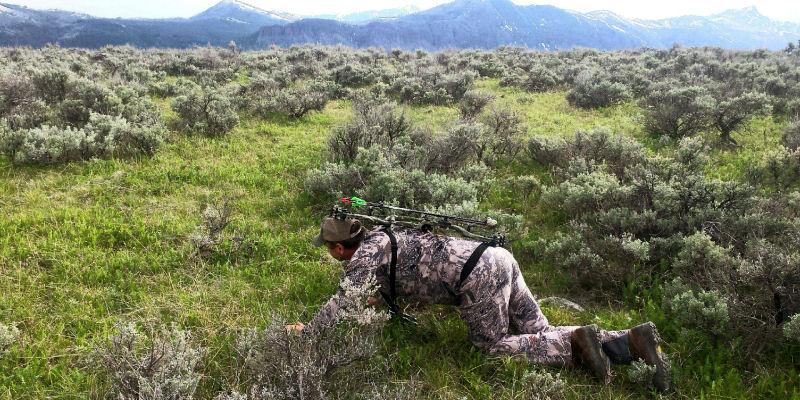
The desolate Wyoming landscape looked more suitable for antelope than elk. The pungent scent of sagebrush stung my nose while my eyes watered from the cold morning air. I was perched on a low sage-covered knoll long before daylight. Bugling bull elk serenaded me, and I eagerly waited for sunrise so my binoculars and spotting scope could reveal the different bulls. The rutting bulls were definitely on the prowl and though their challenging bugles seemed out of place here, they also proved my scouting had paid off. I didn’t stumble onto this area by chance; I researched and scouted very hard to find these elk and the access to get to them. The nearest timber was miles away, probably along with the nearest hunters. That’s just the way I like it!
In many states, elk are expanding into more open terrain, returning to their once historic habitat. Bowhunters should seriously consider scouting and hunting these open country elk – there are some tremendous advantages to hunting these places. 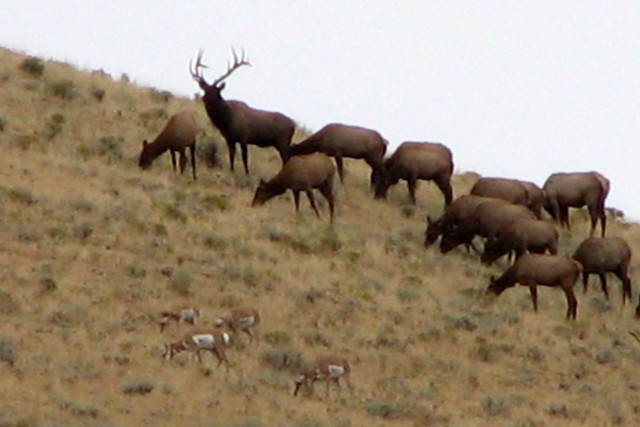 I used to be one of the many bowhunters that shied away from the vast openness of these areas, thinking it foolish and futile to attempt calling or stalking there. In my experience, it seems more and more elk are abandoning what I consider prime elk habitat and congregating for the rut at lower elevations and in desert-like habitat.
I used to be one of the many bowhunters that shied away from the vast openness of these areas, thinking it foolish and futile to attempt calling or stalking there. In my experience, it seems more and more elk are abandoning what I consider prime elk habitat and congregating for the rut at lower elevations and in desert-like habitat.
I believe the main factor for this move during the rut is so the bulls can visually identify and asses the threat of other bulls at a distance, rather than within the close confines of dark timber. It is easier for them to keep track of their cows and calves while in the open. It is also much easier for them to keep other herd bulls and satellite bulls at a distance. There is also less predation from wolves and bears. Many times, we’ve watched as bulls actively worked their herd to avoid contact with another. However, we have also noted that during the peak of the rut, the herd bulls seem much more willing to hold their ground and fight other bulls.
Advantages
The primary advantage of hunting open country elk is their visibility. Being able to spot elk, even at a great distance, is a tremendous advantage over hiking miles of mountain terrain looking for sign or listening for bugles. 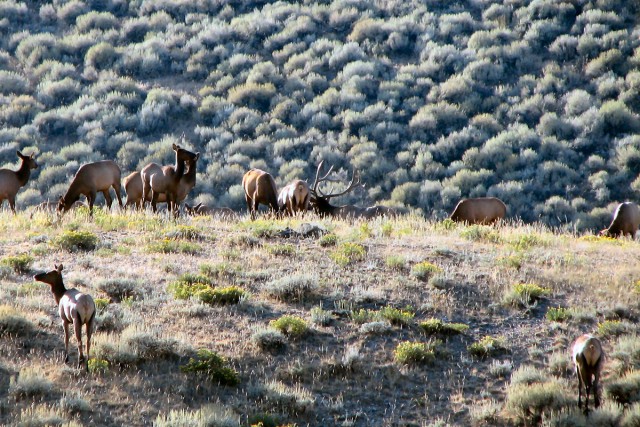 A good glassing setup consisting of 10 power binoculars, tripod, and spotting scope is a must, especially for the hunter looking for a trophy bull. Trying to size up a bull two miles away with just binoculars does not work well. A good spotting scope and tripod is well worth the little extra weight in your pack. It’s safer to determine from a distance if the bull is what you area after, rather than leave your vantage point and hike for a mile or two only to find it’s a smaller bull. Many times, you can observe and pattern a herd from a mile or more away, and take the time to plan a stalk or setup an ambush for another day.
A good glassing setup consisting of 10 power binoculars, tripod, and spotting scope is a must, especially for the hunter looking for a trophy bull. Trying to size up a bull two miles away with just binoculars does not work well. A good spotting scope and tripod is well worth the little extra weight in your pack. It’s safer to determine from a distance if the bull is what you area after, rather than leave your vantage point and hike for a mile or two only to find it’s a smaller bull. Many times, you can observe and pattern a herd from a mile or more away, and take the time to plan a stalk or setup an ambush for another day.
Often times, you will not have much competition hunting the open country. It is difficult for most bowhunters to abandon the traditional mountain habitat and focus solely on open country. For those willing to try, you will probably escape the crowds. Even if you prefer the mountains, expand your opportunity by learning some new country. Sounds will also travel further without the dense vegetation to absorb it, letting you hear bugles from further away. The prevailing winds are also usually more stable in the open terrain, making it easier to plan a stalk.
Comfort Zones and Stalking
Comfort zones for elk will vary somewhat depending on habitat and hunting pressure. Typically, elk in timbered habitat are more sensitive to any movement or noise. 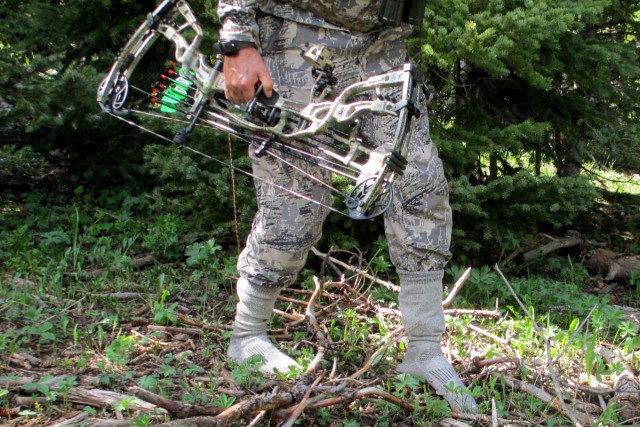 However, they are less likely to move as far as open country elk when spooked. Elk in heavy timber also rely much more on their sense of smell and hearing. Elk in more open habitats rely much more on their eyesight and sense of smell. My personal observation is that open country elk have three distinct comfort zones; over 1000 yards, 500-1000 yards and 0-500 yards. The yardages are approximations.
However, they are less likely to move as far as open country elk when spooked. Elk in heavy timber also rely much more on their sense of smell and hearing. Elk in more open habitats rely much more on their eyesight and sense of smell. My personal observation is that open country elk have three distinct comfort zones; over 1000 yards, 500-1000 yards and 0-500 yards. The yardages are approximations.
Moderate movement over about 1000 yards away doesn’t seem to perk their interest much, especially if you are wearing proper camouflage and blend in with your surroundings. From 1000 yards to 500 yards, you can get away with plenty of movement, as long as it is fairly slow and deliberate. Try to move when the elk are moving or feeding. Be very careful and if you have to move laterally, do so very slowly. Movement closer than 500 yards – unless you have plenty of cover – should be extremely slow and directly at your target. Lateral movement will get you busted. Concentration should always be on the elk, not on your feet. Again, move when they are moving or when they are feeding. Freeze when they lift their head, and do not suddenly drop or crouch! That’s another sure way to get busted.
I often walk and crawl up on elk in low sagebrush habitat. I try to utilize scant cover when it is available, or slow, direct movement when cover is not available. It works. Knee pads and elbow pads are a definite help when in the final stages of your stalk. Balance your bow on your back while crawling. It makes much less noise and movement than pushing or pulling it. Baer’s feet over your boots are recommended, or if not in cactus country, I prefer to slip my boots off and pull an extra pair of wool socks on over the cuff of my pants. This is even quieter than Baer’s feet and doesn’t have as much bulk to snag on brush.
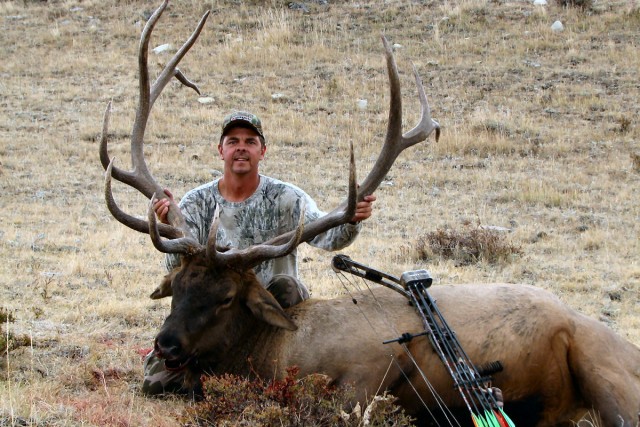 Each bowhunter should expand and test their own personal comfort zones. Oftentimes, we tend to be complacent and hunt the same old areas the same old ways each year. Elk are constantly adapting to changes in their environment, whether it’s habitat, predators or predictable hunting tactics. As hunters, we need to be willing to also adapt to changes. Try some new calls or calling routines. Use a decoy. Try sitting over a wallow. If possible, get to elk country during summer scouting trips and practice stalking elk with a camera to experience for yourself what you can get away with. Every bit of time you spend with elk will make you a better hunter.
Each bowhunter should expand and test their own personal comfort zones. Oftentimes, we tend to be complacent and hunt the same old areas the same old ways each year. Elk are constantly adapting to changes in their environment, whether it’s habitat, predators or predictable hunting tactics. As hunters, we need to be willing to also adapt to changes. Try some new calls or calling routines. Use a decoy. Try sitting over a wallow. If possible, get to elk country during summer scouting trips and practice stalking elk with a camera to experience for yourself what you can get away with. Every bit of time you spend with elk will make you a better hunter.
Conclusion
Maybe you are only comfortable hunting elk in places you have always hunted in the past. That’s great, and it works. If you are ambitious and looking for a little extra adventure, try hunting open country bulls. It is a new experience, and personally, I love being able to spot and stalk bulls. Many of my bulls have been taken in the sagebrush. I still hunt the mountains from time to time, but will always be scouting for open country bulls.

